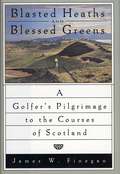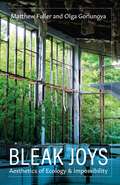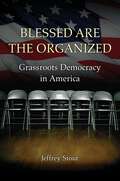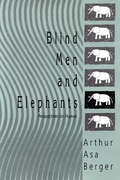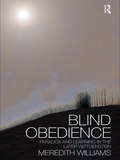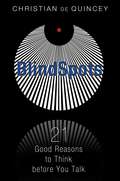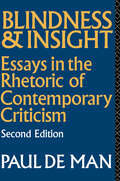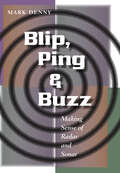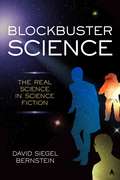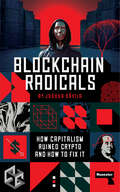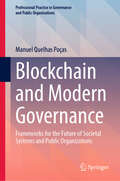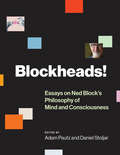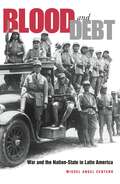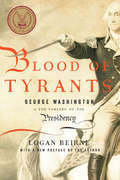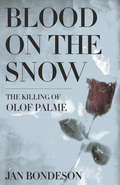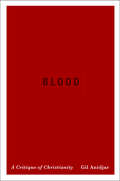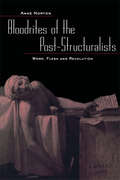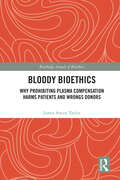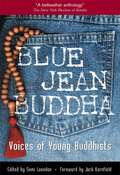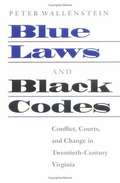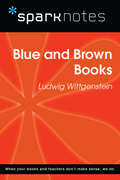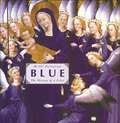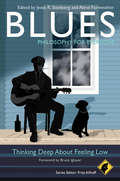- Table View
- List View
Blasted Heaths and Blessed Green: A Golfer's Pilgrimage To The Courses Of Scotland
by James W. FineganEvery golfer alive knows that he or she has two ancestral homes: one's own, and Scotland. On her rolling shores the game of golf had its origins, and to walk the links of St. Andrews is to feel at one with the shepherd who decided one day to see how far he could whack a stone with his crook. Most serious golfers will make the pilgrimage to Scotland, to try to hit the Postage Stamp green at Troon, to trace the footsteps of Ben Hogan at Carnoustie, and to brave the challenge of the Road Hole at St. Andrews; all golfers dream of taking such a trip. For the tourist or the dreamer, there can be no better guide than James W. Finegan. A passionate advocate of the game that's played on the links between land and sea, Finegan combines a writer's eye, a historian's knowledge, and a golfer's sense of wonder and apprehension to provide an impossibly ambitious grand tour of golf's native land. In a loop of a thousand miles that begins in Edinburgh and ends across the Firth of Forth in St. Andrews, Finegan covers some sixty courses, visiting the true shrines of the game, the courses that are well known and respected, and the little-known gems you might otherwise pass right by. He shares the history of the courses, both of their creation and of the most famous matches played there; he also writes marvelously about the scenic and strategic charms to be found as you play them yourself. And he provides all the information you need to make your arrangements to do just that -- because, unlike most championship courses in the United States, the great courses of Scotland are available to the public. In addition to his delightful descriptions of the golf to be found there, Finegan gives us his recommendations for places to stay, ranging from the most modest bed-and-breakfast to the most magnificent castle hotel. He describes the pleasures to be found off the beaten track: the spectacular views from a country road, or the ancient cathedral that's worth a stop on the way to the first tee. And because all the travel within the country is done by car, he spells out the actual routes from town to town and course to course. Blasted Heaths and Blessed Greens is a book to be read, to be savored, and to be tucked away in your suitcase when you finally undertake the journey of your dreams.
Bleak Joys: Aesthetics of Ecology and Impossibility (Posthumanities #53)
by Matthew Fuller Olga GoriunovaA philosophical and cultural distillation of the bleak joys in today&’s ambivalent ecologies and patterns of lifeBleak Joys develops an understanding of complex entities and processes—from plant roots to forests to ecological damage and its calculation—as aesthetic. It is also a book about &“bad&” things, such as anguish and devastation, which relate to the ecological and technical but are also constitutive of politics, the ethical, and the formation of subjects.Avidly interdisciplinary, Bleak Joys draws on scientific work in plant sciences, computing, and cybernetics, as well as mathematics, literature, and art in ways that are not merely illustrative of but foundational to our understanding of ecological aesthetics and the condition in which the posthumanities are being forged. It places the sensory world of plants next to the generalized and nonlinear infrastructure of irresolvability—the economics of indifference up against the question of how to make a home on Planet Earth in a condition of damaged ecologies. Crosscutting chapters on devastation, anguish, irresolvability, luck, plant, and home create a vivid and multifaceted approach that is as remarkable for its humor as for its scholarly complexity.Engaging with Deleuze, Guattari, and Bakhtin, among others, Bleak Joys captures the modes of crises that constitute our present ecological and political condition, and reckons with the means by which they are not simply aesthetically known but aesthetically manifest.
Blended Language Program Evaluation
by Paul Gruba Mónica S. Cárdenas-Claros Ruslan Suvorov Katherine RickAdvocating an argument-based approach, Blended Language Program Evaluation presents a framework for planning, conducting, and appraising evaluation of blended language learning across three institutional levels, and demonstrates its utility and application in four case studies carried out in diverse international contexts.
Blessed Are the Organized: Grassroots Democracy in America
by Jeffrey StoutHow ordinary citizens band together to bring about real changeIn an America where the rich and fortunate have free rein to do as they please, can the ideal of liberty and justice for all be anything but an empty slogan? Many Americans are doubtful, and have withdrawn into apathy and cynicism. But thousands of others are not ready to give up on democracy just yet. Working outside the notice of the national media, ordinary citizens across the nation are meeting in living rooms, church basements, synagogues, and schools to identify shared concerns, select and cultivate leaders, and take action. Their goal is to hold big government and big business accountable. In this important new book, Jeffrey Stout bears witness to the successes and failures of progressive grassroots organizing, and the daunting forces now arrayed against it.Stout tells vivid stories of people fighting entrenched economic and political interests around the country. From parents and teachers striving to overcome gang violence in South Central Los Angeles, to a Latino priest north of the Rio Grande who brings his parish into a citizens' organization, to the New Orleans residents who get out the vote by taking a jazz band through streets devastated by Hurricane Katrina, Stout describes how these ordinary people conceive of citizenship, how they acquire and exercise power, and how religious ideas and institutions contribute to their successes.The most important book on organizing and grassroots democracy in a generation, Blessed Are the Organized is a passionate and hopeful account of how our endangered democratic principles can be put into action.
Blind Men and Elephants: Perspectives on Humor
by Arthur Asa BergerIn Blind Men and Elephants, Arthur Asa Berger uses case histories to show how scholars from different disciplines and scholarly domains have tried to describe and understand humor. He reveals not only the many approaches that are available to study humor, but also the many perspectives toward humor that characterize each discipline. Each case history sheds light on a particular aspect of humor, making the combination of approaches of considerable value in the study of social research.Among the various disciplines that Berger discusses in relation to humor are: communication theory, philosophy, semiotics, literary analysis, sociology, political science, and psychology. Berger deals with these particular disciplines and perspectives because they tend to be most commonly found in the scholarly literature about humor as well as being those that have the most to offer. Blind Men and Elephants covers a wide range of humor, from simple jokes to the uses of literary devices in films. Berger observes how humor often employs considerable ridicule directed at diverse groups of people: women, men, animals, politicians, African Americans, Jews, Catholics, Protestants, gay people, straight people, and so forth. The book also explains the risk factor in ridicule as a humorous device.Blind Men and Elephants depicts how one entity or one situation can be viewed in as many different ways as the number of people studying it. Berger also shows how those multiple perspectives, the Rashomon Effect, can be used together to create a clearer understanding of humor. Blind Men and Elephants is a valuable companion to Berger's recent effort about humor, An Anatomy of Humor, and will be enjoyed by communication and information studies scholars, sociologists, literary studies specialists, philosophers, and psychologists.
Blind Obedience: The Structure and Content of Wittgenstein's Later Philosophy
by Meredith WilliamsThere is considerable debate amongst philosophers as to the basic philosophical problem Wittgenstein is attempting to solve in Philosophical Investigations. In this bold and original work, Meredith Williams argues that it is the problem of "normative similarity". In Blind Obedience Williams demonstrates how Wittgenstein criticizes traditional, representationalist theories of language by employing the ‘master/novice’ distinction of the learner, arguing that this distinction is often overlooked but fundamental to understanding philosophical problems about mind and language. The book not only provides revealing discussions of Wittgenstein’s corpus but also intricate analyses of the work of Brandom, Dummett, Frege, Sellars, Davidson, Cavell and others. These are usefully compared in a bid to better situate Wittgenstein’s non-intellectualist, non-theoretical approach and to highlight is unique features.
BlindSpots: 21 Good Reasons to Think before You Talk
by Christian De QuinceyExamines 21 unquestioned assumptions that cloud our collective consciousness • Reveals faulty thinking and conceptual blindspots that distort beliefs in science, philosophy, and spirituality--from “the universe exploded from nothing in a Big Bang” to “we create our own reality” • Explains how “thought viruses” spread as we use these clichéd assumptions in our daily communications We live in a world filled with clichés--convenient assumptions and unquestioned conclusions that many of us use without giving them a second thought. We all spread these “thought viruses,” infecting everyone we come in contact with. But many of these blindspots in how we think about ourselves and the world do not withstand rigorous scrutiny--or even casual scrutiny in some cases--yet they fall out of the mouths of scientists, religious teachers, journalists, and authors with dumbfounding frequency. Over the years philosopher Christian de Quincey spotted these cognitive gremlins in books, blogs, websites, TV shows, movies, classrooms, and casual conversations--and he wondered: Why do so many people speak before thinking, spreading ideas that make no sense, yet fool us into thinking they do? How did these unquestioned beliefs about life, space, time, energy, consciousness, evolution, artificial intelligence, and even God take hold in our collective consciousness? In this book, de Quincey deliberately provokes and illuminates the dark side of jumping to conclusions, casting a skeptical eye on 21 beliefs that keep science, philosophy, and spirituality in the dark--from “the universe exploded from nothing in a Big Bang” and “we create our own reality” to “nobody knows what consciousness is” and “everything is energy.” These ideas distort and block our understanding and openness to important questions about life, the universe, mind, matter, God, and the miraculous. By exposing these thought viruses that take our minds hostage when we fail to think things through, de Quincey aims to help change the way we think not just about thinking but also about how we live our lives, interact with others, and contemplate the world around us.
Blindness and Insight: Essays in the Rhetoric of Contemporary Criticism
by Paul De ManFirst published in 1983. Routledge is an imprint of Taylor & Francis, an informa company.
Blip, Ping, and Buzz: Making Sense of Radar and Sonar
by Mark DennyHave you ever wondered how stealth planes achieve "invisibility," how sunken ships are found, or how fishermen track schools of fish in vast expanses of ocean? Radar and sonar echolocation—a simple matter of sending, receiving, and processing signals.Weaving history with simple science, Mark Denny deftly reveals the world of radar and sonar to the curious reader, technology buff, and expert alike. He begins with an early history of the Chain Home radar system used during World War II and then provides accessible and engaging explanations of the physics that make signal processing possible. Basic diagrams and formulas show how electromagnetic and sound waves are transmitted, received, and converted into images, allowing you to literally see in the dark.A section on bioacoustic echolocation, with a focus on the superior sonar systems of bats and whales and a discussion of the advanced technology of next-generation airborne signal processors, opens the imagination to fascinating possibilities for the future.
Blockbuster Science: The Real Science in Science Fiction
by David Siegel BernsteinIf you've ever wondered how much real science goes into movies like Gravity, novels like The Martian, and television shows like Doctor Who, this is the book for you. Written by an author who is both a data scientist and a science fiction writer, this entertaining and accessible book uses popular science fiction movies, stories, and TV shows to explain the science behind popular narrative concepts like time travel, lightsabers, AI, genetic mutation, asteroids, cyborgs, black holes, alien invasion, the zombie apocalypse, and more.What could be a more fun way to explore the world of science than through its use—accurately or fantastically—in science fiction entertainment: movies, books, and TV shows?Learn about relativity through Orson Scott Card's Ender's Game and the movie Interstellar; black holes and wormholes in connection with Contact and Planet of the Apes; theories about the origin of life as reflected in Battlestar Galactica, Star Trek: The Next Generation, and The Hitchhiker's Guide to the Galaxy; computer science and artificial intelligence in reference to A.I. Artificial Intelligence; and much, much, more.Written with wit, clarity, and a great sense of fun, Blockbuster Science will inspire science fiction fans to get excited about real science while also putting an engaging pop culture spin on science for any curious reader.
Blockchain Radicals: How Capitalism Ruined Crypto and How to Fix It
by Joshua DávilaBlockchain Radicals uncovers the radical political potential of the blockchain, showing how it can be used by the left in the fight against capitalism.The blockchain is often understood only in its simplistic relationship to financial speculation and marketed as a way to onboard potential customers into the crypto economy. But what if it held a more radical potential that was waiting to be unlocked?By moving past simply equating the blockchain with cryptocurrency and instead trying to understand what these tools do and how they work, Blockchain Radicals shows how the blockchain can be used by a left that is in need of new ideas in its struggle to create a better world for all. Steering between boosters on the right and cynics on the left, it shows us how the blockchain is a space where new post-capitalist strategies and collectives are already emerging.Questioning all the assumptions we have about currencies, markets, information, politics, and its limitations, the blockchain allows us to begin moving past the question of why the future has seemed to be standing still for so long.
Blockchain and Modern Governance: Frameworks for the Future of Societal Systems and Public Organizations (Professional Practice in Governance and Public Organizations)
by Manuel Quelhas PoçasThis book shows how blockchain technology can transform the foundational systems of our society. Written by an industry expert with a background in political science, international relations, law, management, and technology, the book merges social, political, economic, and legal theories with technological expertise to present a groundbreaking framework for using blockchain in governance and public organizations. Imagine a country as a digital space where humans and resources interact seamlessly. This book explores such possibilities, illustrating how blockchain can redefine governance beyond physical borders. Addressing the urgent need for adaptive solutions in a globally interconnected world, the author provides a strategic roadmap for implementing blockchain in public governance. With clear explanations, real-world examples, and practical applications, this book will inspire and guide professionals and policy-makers seeking to utilize blockchain technology for innovative governance solutions.
Blockheads!: Essays on Ned Block's Philosophy of Mind and Consciousness (The\mit Press Ser.)
by Daniel Stoljar Adam PautzNew essays on the philosophy of Ned Block, with substantive and wide-ranging responses by Block.Perhaps more than any other philosopher of mind, Ned Block synthesizes philosophical and scientific approaches to the mind; he is unique in moving back and forth across this divide, doing so with creativity and intensity. Over the course of his career, Block has made groundbreaking contributions to our understanding of intelligence, representation, and consciousness. Blockheads! (the title refers to Block's imaginary counterexample to the Turing test—and to the Block-enthusiast contributors) offers eighteen new essays on Block's work along with substantive and wide-ranging replies by Block. The essays and responses not only address Block's past contributions but are rich with new ideas and argument. They importantly clarify many key elements of Block's work, including his pessimism concerning such thought experiments as Commander Data and the Nation of China; his more general pessimism about intuitions and introspection in the philosophy of mind; the empirical case for an antifunctionalist, biological theory of phenomenal consciousness; the fading qualia problem for a biological theory; the link between phenomenal consciousness and representation (especially spatial representation); and the reducibility of phenomenal representation. Many of the contributors to Blockheads! are prominent philosophers themselves, including Tyler Burge, David Chalmers, Frank Jackson, and Hilary Putnam.ContributorsNed Block, Bill Brewer, Richard Brown, Tyler Burge, Marisa Carrasco, David Chalmers, Frank Jackson, Hakwan Lau, Geoffrey Lee, Janet Levin, Joseph Levine, William G. Lycan, Brian P. McLaughlin, Adam Pautz, Hilary Putnam, Sydney Shoemaker, Susanna Siegel, Nicholas Silins, Daniel Stoljar, Michael Tye, Sebastian Watzl
Blood and Debt: War and the Nation-State in Latin America
by Miguel Angel CentenoWhat role does war play in political development? Our understanding of the rise of the nation-state is based heavily on the Western European experience of war. Challenging the dominance of this model, Blood and Debt looks at Latin America's much different experience as more relevant to politics today in regions as varied as the Balkans and sub-Saharan Africa. The book's illuminating review of the relatively peaceful history of Latin America from the late eighteenth through the early twentieth centuries reveals the lack of two critical prerequisites needed for war: a political and military culture oriented toward international violence, and the state institutional capacity to carry it out. Using innovative new data such as tax receipts, naming of streets and public monuments, and conscription records, the author carefully examines how war affected the fiscal development of the state, the creation of national identity, and claims to citizenship. Rather than building nation-states and fostering democratic citizenship, he shows, war in Latin America destroyed institutions, confirmed internal divisions, and killed many without purpose or glory.
Blood of Tyrants
by Logan BeirneBlood of Tyrants reveals the surprising details of our Founding Fathers' approach to government and this history's impact on today. Delving into the forgotten-and often lurid-facts of the Revolutionary War, Logan Beirne focuses on the nation's first commander in chief, George Washington, as he shaped the very meaning of the United States Constitution in the heat of battle.Key episodes illustrate how the Founders dealt with thorny wartime issues: Who decides war strategy? When should we use military tribunals over civilian trials? Should we inflict harsh treatment on enemy captives if it means saving American lives? How do we protect citizens' rights when the nation is struggling to defend itself? Beirne finds evidence in previously-unexplored documents such as General Washington's letters debating torture, an eyewitness account of the military tribunal that executed a British prisoner, Founders' letters warning against government debt, and communications pointing to a power struggle between Washington and the Continental Congress.Vivid stories from the Revolution frame Washington's pivotal role in the drafting of the Constitution. The Founders saw the first American commander in chief as the template for all future presidents: a leader who would fiercely defend Americans' rights and liberties against all forms of aggression.Blood of Tyrants pulls the reader directly into the scenes, filling the void in our understanding of the presidency and our ingenious Founders' pragmatic approach to issues we still face today.
Blood on the Snow: The Killing of Olof Palme
by Jan BondesonThe Swedish Prime Minister Olof Palme, a major figure in world politics and an ardent opponent of apartheid, was shot dead on the streets of Stockholm in February 1986. At the time of his death, Palme was deeply involved in Middle East diplomacy and was working under UN auspices to end the Iran–Iraq war. Across Scandinavia, Palme's killing had an impact similar to that of the Kennedy assassinations in the United States—and it ignited nearly as many conspiracy theories. Interest in the Palme slaying was most recently stirred by reports of the death of Christer Pettersson, who was tried for the murder twice, convicted the first time, and then acquitted on appeal. In his investigative account of Palme's still-unsolved murder, the historian Jan Bondeson meticulously recreates the assassination and its aftermath. Like the best works of crime fiction, this book puts the victim and his death into social context. Bondeson's work, however, is noteworthy for its dispassionate treatment of police incompetence: the police did not answer a witness’s phone call reporting the murder just 45 seconds after it occurred, and further time was lost as the police sought to confirm that someone had actually been shot. When the police arrived on the scene, they did not even recognize the victim as the Prime Minister. This early confusion was emblematic of the errors that were to follow. Bondeson demolishes the various conspiracy theories that have been devised to make sense of the killing, before suggesting a convincing explanation of his own. A brilliant piece of investigative journalism, Blood on the Snow includes crime-scene photographs and reconstructions that have never before been published and offers a gripping narrative of a crime that shocked a continent.
Blood: A Critique of Christianity (Religion, Culture, and Public Life #19)
by Gil AnidjarBlood, according to Gil Anidjar, maps the singular history of Christianity. As a category for historical analysis, blood can be seen through its literal and metaphorical uses as determining, sometimes even defining Western culture, politics, and social practices and their wide-ranging incarnations in nationalism, capitalism, and law.Engaging with a variety of sources, Anidjar explores the presence and the absence, the making and unmaking of blood in philosophy and medicine, law and literature, and economic and political thought from ancient Greece to medieval Spain, from the Bible to Shakespeare and Melville. The prevalence of blood in the social, juridical, and political organization of the modern West signals that we do not live in a secular age into which religion could return. Flowing across multiple boundaries, infusing them with violent precepts that we must address, blood undoes the presumed oppositions between religion and politics, economy and theology, and kinship and race. It demonstrates that what we think of as modern is in fact imbued with Christianity. Christianity, Blood fiercely argues, must be reconsidered beyond the boundaries of religion alone.
Bloodrites of the Post-Structuralists: Word Flesh and Revolution
by Anne NortonHow do you write history when it's no longer linear? In Bloodrites of the Post-Structuralists, respected political theorist Anne Norton reminds us of the real interplay between words (laws, scriptures, myths, and texts), and the world of flesh. Drawing from sources as diverse as foundational myths from Sarah in the bible, Marat in his death bath, and thinkers like Hegel and Foucault, Norton reinterprets the relationship between word and flesh and places it in historical context. The French and English Revolutions, as well as the period of anti-colonialism and post-colonialism are used to frame her discussion of word and body, and their historical significance.
Bloody Bioethics: Why Prohibiting Plasma Compensation Harms Patients and Wrongs Donors (Routledge Annals of Bioethics)
by James Stacey TaylorThis is the first book to argue in favor of paying people for their blood plasma. It does not merely argue that offering compensation to plasma donors is morally permissible. It argues that prohibiting donor compensation is morally wrong—and that it is morally wrong for all of the reasons that are offered against allowing donor compensation. Opponents of donor compensation claim that it will reduce the amount and quality of plasma obtained, exploit and coerce donors, and undermine social cohesion. James Stacey Taylor argues that empirical evidence demonstrates that compensating plasma donors greatly increases the amount of plasma obtained with no adverse effects on the quality of the pharmaceutical products that are manufactured from it. Prohibiting compensation thus harms patients by reducing their access to the medicines they need. He also argues that it is the prohibition of compensation—not its offer—that exploits donors, fails to respect the moral need to secure a person’s authoritative consent to her treatment, and prevents donors from giving their informed consent to donate. Prohibiting compensation thus not only harms patients but also wrongs donors. Bloody Bioethics will appeal to researchers, advanced students, and medical professionals interested in bioethics, moral philosophy, and the moral limits of markets.
Blue Extinction in Literature, Art, and Culture (Palgrave Studies in Animals and Literature)
by Rachel Murray Vera FibisanBlue Extinction in Literature, Culture, and Art examines literary and cultural representations of aquatic biodiversity loss, bringing together critical perspectives from the blue humanities and extinction studies. It demonstrates the affordances, as well as the limitations, of literary and artistic forms in exposing the plight of aquatic organisms, drawing attention to the social, political, and economic structures that are contributing to their destruction. Together, the essays in this collection demonstrate how literature and art can challenge dominant cultural conceptions and lingering misconceptions surrounding aquatic biodiversity loss, offering new ways of relating to species ranging from whales to oysters.
Blue Jean Buddha
by Jack Kornfield Sumi LoundonIn an age when the Dalai Lama's image has been used to sell computers, rock stars have used tantra to enhance their image, and for many, Nirvana calls to mind a a favorite band, what does Buddhism mean to twenty-somethings? Blue Jean Buddha offers real stories about young Buddhists in their own words that affirm and inform the young adult Buddhist experience. This one-of-a-kind book is about the experiences of young people in America-from their late teens to early thirties-who have embraced Buddhism. Thirty-three first-person narratives reflect on a broad range of life-stories, lessons, and livelihood issues, such as growing up in a Zen center, struggling with relationships, caring for the dying, and using marathon running as meditation. Throughout, up-and-coming author Sumi Loundon provides an illuminating context for the tremendous variety of experiences shared in the book. Blue Jean Buddha was named a finalist in the 2002 Independent Publisher Book Awards (Multicultural Non-Fiction - Young Adult) as well in NAPRA's Nautilus Awards, in the Personal Journey/Memoir/Biography category.
Blue Laws and Black Codes: Conflict, Courts, and Change in Twentieth-century Virginia
by Peter WallensteinWomen were once excluded everywhere from the legal profession, but by the 1990s the Virginia Supreme Court had three women among its seven justices. This is just one example of how law in Virginia has been transformed over the past century, as it has across the South and throughout the nation.In Blue Laws and Black Codes, Peter Wallenstein shows that laws were often changed not through legislative action or constitutional amendment but by citizens taking cases to state and federal courtrooms. Due largely to court rulings, for example, stores in Virginia are no longer required by "blue laws" to close on Sundays. Particularly notable was the abolition of segregation laws, modified versions of southern states' "black codes" dating back to the era of slavery and the first years after emancipation. Virginia's long road to racial equality under the law included the efforts of black civil rights lawyers to end racial discrimination in the public schools, the 1960 Richmond sit-ins, a case against segregated courtrooms, and a court challenge to a law that could imprison or exile an interracial couple for their marriage.While emphasizing a single state, Blue Laws and Black Codes is framed in regional and national contexts. Regarding blue laws, Virginia resembled most American states. Regarding racial policy, Virginia was distinctly southern. Wallenstein shows how people pushed for changes in the laws under which they live, love, work, vote, study, and shop--in Virginia, the South, and the nation.
Blue and Brown Books (SparkNotes Philosophy Guide)
by SparkNotesBlue and Brown Books (SparkNotes Philosophy Guide) Making the reading experience fun! SparkNotes Philosophy Guides are one-stop guides to the great works of philosophy–masterpieces that stand at the foundations of Western thought. Inside each Philosophy Guide you&’ll find insightful overviews of great philosophical works of the Western world.
Blue: The History of a Color
by Michel PastoureauA beautifully illustrated visual and cultural history of the color blue throughout the agesBlue has had a long and topsy-turvy history in the Western world. The ancient Greeks scorned it as ugly and barbaric, but most Americans and Europeans now cite it as their favorite color. In this fascinating history, the renowned medievalist Michel Pastoureau traces the changing meanings of blue from its rare appearance in prehistoric art to its international ubiquity today. Any history of color is, above all, a social history. Pastoureau investigates how the ever-changing role of blue in society has been reflected in manuscripts, stained glass, heraldry, clothing, paintings, and popular culture. Beginning with the almost total absence of blue from ancient Western art and language, the story moves to medieval Europe. As people began to associate blue with the Virgin Mary, the color became a powerful element in church decoration and symbolism. Blue gained new favor as a royal color in the twelfth century and became a formidable political and military force during the French Revolution. As blue triumphed in the modern era, new shades were created and blue became the color of romance and the blues. Finally, Pastoureau follows blue into contemporary times, when military clothing gave way to the everyday uniform of blue jeans and blue became the universal and unifying color of the Earth as seen from space.Beautifully illustrated, Blue tells the intriguing story of our favorite color and the cultures that have hated it, loved it, and made it essential to some of our greatest works of art.
Blues - Philosophy for Everyone: Thinking Deep About Feeling Low (Philosophy for Everyone #46)
by Fritz AllhoffThe philosophy of the blues From B.B. King to Billie Holiday, Blues music not only sounds good, but has an almost universal appeal in its reflection of the trials and tribulations of everyday life. Its ability to powerfully touch on a range of social and emotional issues is philosophically inspiring, and here, a diverse range of thinkers and musicians offer illuminating essays that make important connections between the human condition and the Blues that will appeal to music lovers and philosophers alike.
